As an Amazon Associate I earn from qualifying purchases.
Anyone who has ever served wild game to someone unfamiliar with it has probably heard them say something like, “This is… gamey.” So-called gamey meat is the bane of a hunter’s existence, but putting your finger on what is and is not gamey is no easy task.
There are two sources for gaminess in meat: Unfamiliar flavors, and meat that is tainted or otherwise “off.” I’ll go into both here.
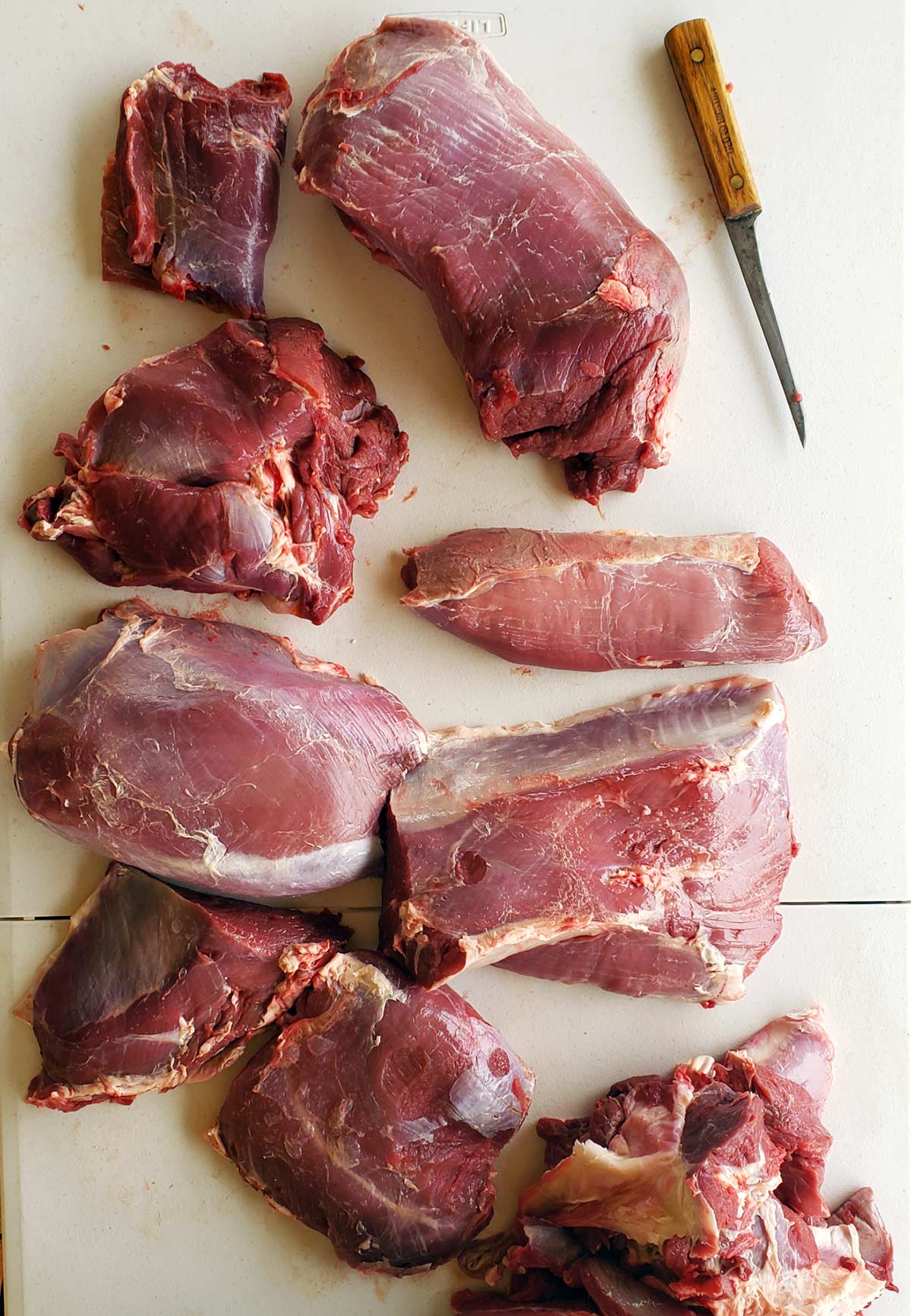
First and foremost, gamey meat is, well, game. Hunted meat. Mostly. Several farmed animals, notably lamb (mutton), older goats and guinea hens can also be perceived as gamey.
That said, over the decades, I have heard pretty much everything called gamey, even rabbit and quail, which I think are the mildest of all meats. I once heard a contestant on the TV show “Top Chef” extoll the flavor of farmed quail because of how gamey it is. Uh… dude. Farmed quail is so flavorless and mild, it’s the closest thing to Soylent Green I’ve had other than maybe tilapia.
At its core, gamey meat means meat that tastes differently from standard, store-bought, farmed meats. It is neither good nor bad, although I’ll get to cases where is it most definitely bad.
But what causes gaminess? Several reasons, starting with the nice ones.
Diet
This is the primary reason. Supermarket meats are fed almost entirely on corn. And corn lends a specific flavor to meats, one we now regard as standard. It is a bland, approachable flavor. Fat from corn-fed animals is firmer and more saturated than those eating most other things, notably nuts or grass. You can see this clearly in pork. Corn finished pork fat is strikingly harder and milder than fat from hogs finished on nuts.
For the most part, wild animals eat things other than corn. And yes, I know there are lots of wild animals that do eat corn, notably whitetail deer, ducks, geese, pheasants and hogs. But even these animals don’t subsist entirely on corn, which is why a pheasant doesn’t taste like a chicken, even though they are cousins.
(All about the intricacies of wild game fat, and why you might want to hunt specifically for it, are in this article.)
Gamey meat is almost entirely a function of the flavors in skin and fat. Most of the stronger aromas we perceive in meat are fat soluble and reside in that fat. A prime example is in waterfowl. A scoter eats mostly clams, and its fat is pretty nasty (to most people). But if you skin this bird, its meat is not terribly different from that of a similarly skinned mallard. Ditto for spoonies, the northern shoveler.
Most striking, at least to me, are ptarmigan and spruce grouse. These birds’ diet of berries, forbs, lichen and conifer needles makes them the most pungent and powerful of all game birds. You either like them or not, but gamey they are most definitely.
For big game, I’ve noticed that the diet of a Coues deer, a little subspecies of whitetail that lives in the Desert Southwest, alters its fat enough to where it does not coat your mouth the way fat from a grain-fed whitetail in, say, Illinois would. I’ve had very sagey mule deer, and mild ones. It’s the fat.
(I have a whole article on the complexities of deer fat here.)
And if you manage to remove all the fat from a slab of mutton, it will be much more mild than one with its fat cap. Interestingly, one main reason lamb is thought of as gamey is because of all our domesticated meats, lamb is the one most often raised entirely on grass. Only Colorado lamb is commonly finished on grain.
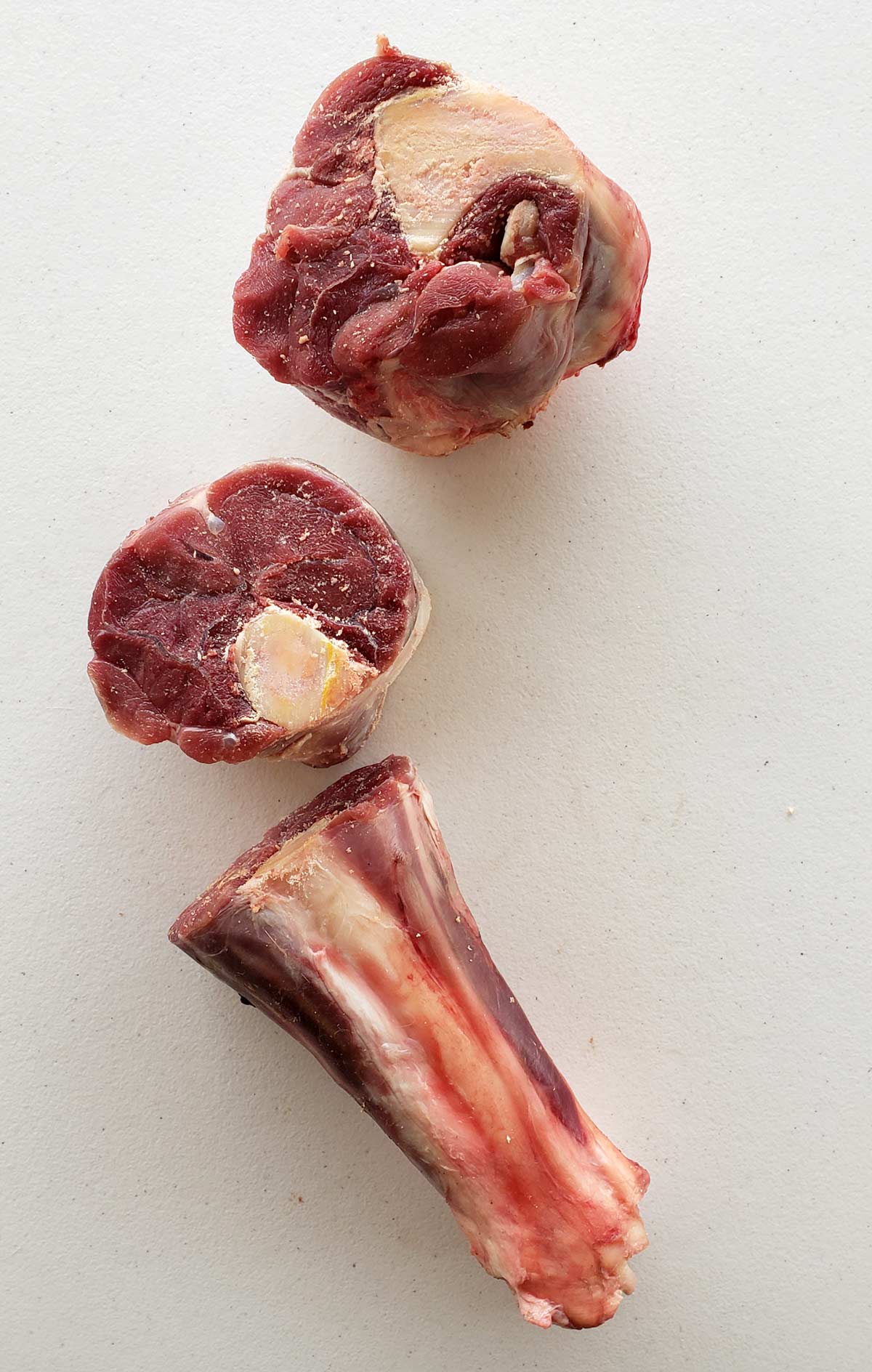
Older Athletes
A second, important reason for so-called gamey meat is the fact that wild animals are older and are far more athletic than their domesticated counterparts.
Typically, hunters bring home deer that are several years old, and elk, bear and moose can push 10 years old or more. Most birds killed by hunters are young of the year, but waterfowl can live beyond 30 years old, and five-year-old turkeys are not impossible.
And even young-of-the-year birds are typically older than their domestic cousins. A fryer chicken can be as little as five weeks old. No quail, pheasant, partridge or duck is that young. In fact, the youngest wild animal we commonly hunt is a dove. In some rare cases, month-old doves can be shot in warm places, where their parents raise up to six broods a year.
Furthermore, even young-of-the-year game animals work for a living. Their tendons are stronger, their meat is denser, and they are normally far leaner than their couch potato relatives in the barnyard. All of this has an effect on flavor.
Now consider an old Canada goose, which can be up to 30 years old. Its flavor will be radically different from a five-month old domestic goose, and even the youngest wild goose will be six months old.
In all these contexts, “gamey meat” equals meat with character, with depth, and with flavor wholly of itself.
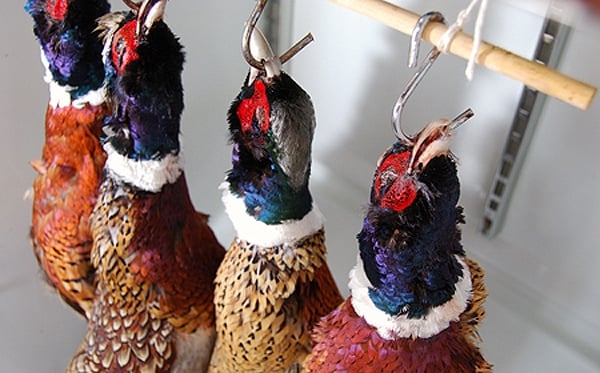
Aged Meat is Gamey
Now we should talk about aged meat. Simply put, aged meat is gamey. To most, in a good way. To the uninitiated, it can be an overwhelming experience.
Let’s start with aged beef, because that’s what most of us have experience with… except I am betting that you haven’t, because true, real aged beef is at least three weeks old, and you don’t really get into the kaleidoscopic world of aged beef flavors until you cross a month.
Really well-aged beef shares a lot, flavorwise, with blue cheese. It’s stinky in an oddly attractive way, and ultra tender. No teeth needed.
All of this can apply to wild game, too. You can certainly dry age venison for a month, and it will start to take on some of those richer, more savory, almost cheesy tones. Venison won’t get as cheesy as beef because it lacks internal fat, but it will change, profoundly, if properly aged. (Read my detailed tutorial on dry aging meat – even without a fancy dry ager – here.)
Birds are famous for this. A well-aged pheasant is a wondrous thing. A fresh pheasant is a boring chicken.
(I have an entire guide to hanging pheasants and other game birds here.)
In fact, the process of hanging, aging game birds is called faisandage in French, after their word for pheasant, which is faisan. In English it’s called mortification. This combination of bacterial and enzymatic action on meat intensifies flavor and aroma and umami.
Done well, it is the pinnacle of wild game flavor. And it is most definitely gamey meat. In a good way.
Bad Gamey
OK, now we need to talk about gamey meat in a bad way. Because it’s real.
Most of us have had wild game that is, well… off. Twangy. Sour. Smelly. Not sexy-musky — rotten, pungent, attack-the-nostrils stinky. I’ve most often encountered this with big game, usually some sort of cervid like a deer or elk, and, very commonly, pronghorn.
This sort of gamey meat is, usually, all about poor hygiene and meat handling. This is the hallmark of a mistake, or, more likely, several mistakes.
Allow me to use the much maligned pronghorn as an example. Historically, pronghorn are hunted in early fall by multiple hunters. This is a generalization, but I’ve seen it many, many times. Let’s say there are five of us. Most of us shoot our speed goat early in the morning, but Poor Guy Five can’t seem to buy a break. He misses one, maybe two, and doesn’t connect on his until, say, 3 o’clock in the afternoon.
Only now do we all start gutting and skinning our animals. Poor Guy Five’s pronghorn will be nice, but everyone else’s will be ruined. Even if we’d all gutted our antelope as we’d shot them, it’d still be a mess because the skin on a pronghorn holds heat better than that of a deer, and you are often hunting in 75°F weather.
Similarly, waterfowl are often so fat they retain enough heat that if you don’t chill them down, if you are hunting in warm weather they can go off in the course of an afternoon.
And with large animals, like moose, if you don’t cool them down ASAP, there’s a condition called bone sour that can ruin the whole animal. But imagine if this was your hunt of a lifetime? You’re going to take that meat anyway. But you better believe it will be some seriously gamey meat.
Bad bacteria really enjoy temperatures over 60°F, and with red meat, anything much over 40°F for any length of time means trouble.
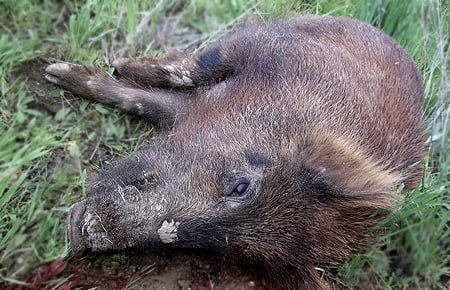
There is another big source of bad gaminess in meat: Hormones. This is almost exclusively with mammals.
Anyone who has shot a big ole’ boar hog, or a huge, rutty buck, knows what I am talking about. The testosterone in these animals stinks, and taints the meat. Now don’t get me wrong, it’s still edible, but there is a noticeable flavor and aroma to a testosterone-soaked animal. Holly says she knows when I am cooking a male pig, and her guess is almost never wrong.
Hormones in rutting bucks and bulls affect flavor, too. In addition, a rutting animal will lose weight and fat, and will be fighting constantly, stressing muscles and increasing the potential for old wounds in the meat, caused by sparring.
Finally, how you kill the animal matters. A stressed animal’s meat will never be as good as one that was not stressed. This too is because of hormones. The meat industry goes to great lengths to design its killing facilities in such a way as to not stress the animals — not so much for humane slaughter as for meat quality.
So the next time you “shot a little far back,” and wondered why your meat was gamey, that could be why. Needless to say shooting a fleeing animals falls into this, too.
Taming Gamey Meats
I’ll be honest: There’s not a lot to do about truly gnarly, gamey meat. I mean, I once make about 50 pounds of Mexican chorizo from a boar, but it still had a twang of ‘nads on a hot day.
That said, you can remove the gamey taste of game in several ways. First is to brine it in a solution of 1/4 cup kosher salt to 1 quart water overnight; that’s the ratio, since you will often need more than a quart.
A second method is to soak meat in milk in the fridge overnight. I will often do this to kidneys and livers of big game animals, which can be off-puttingly smelly without this treatment.
A red wine soak is a good call, too — if you are planning to cook your meat in a stew or somesuch. One important tip: Boil the wine first, then cool. If you don’t do this, you will get a weird, metallic flavor that I believe comes from the alcohol, which is burned off by the boil. You can soak gamey meat in pre-boiled red wine for several days in the fridge.
Finally, practicing good meat care is an obvious one, as is being careful to not cut things like tarsal glands in deer or the scent gland in a javelina. Also, ice is your friend. Cold meat equals good meat.


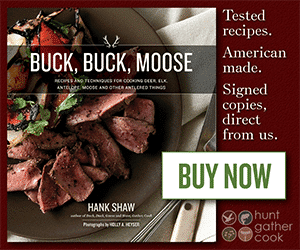


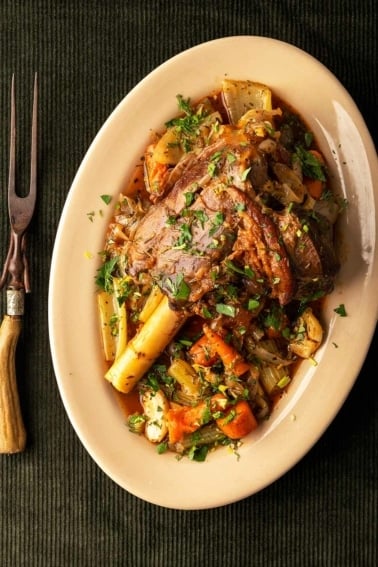
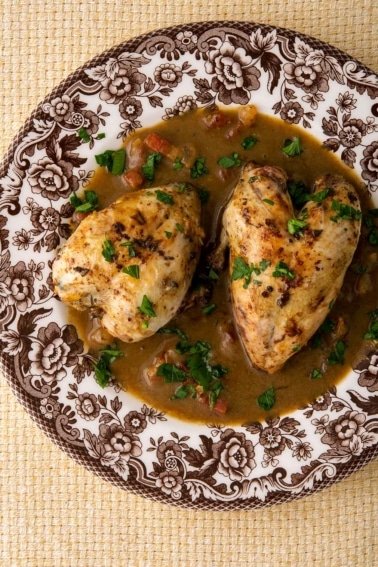
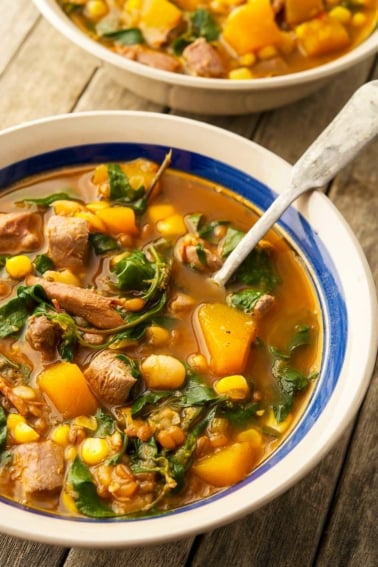
Your articles and readers comments are always informative. I keep recycled plastic containers filled with water one inch from the top in my freezer. Most are 1/2 gal or 1 gal that formerly contained juice.
Placing meat in game bags in a cooler with the frozen bottles allows the meat to breathe, stay dry by avoiding leaking, melting ice in bags and eliminates the plastic bag problem.
I’ve never been a hunter (although your writing may eventually turn me into one) – I’m on your mailing list primarily for your missives from the kitchen and garden – but this is an excellent and educational read, thanks Hank!
Great article!
We soak strong meat in buttermilk.
Spruce grouse is by far my favorite game bird, stuffed with lingonberries and baked or flour dusted and cooked in bacon fat.
I wish you had addressed field hygiene more thoroughly, my husband and I have observed some horrendous practices and contamination of meat is a sure way to ruin it. There’s no excuse for it but education is scarce.
CJ: I’ve dealt with field hygiene extensively in all my books.
Hank I have eaten 100’s of boar pigs. The biggest problem I have witnessed is people gutting the boar. when they do they cut through the gland that surrounds the penis. You will ruin the meat, ice chest and anything the meat comes in contact with. I strip skin the pig male or female removing just enough hide to remove the quarters, backstrap and tender loins. It gets the meat on ice faster to get it cooling down. Always like your segments. I have a How To on my website.
Buddy: That’s a great tip. Had not heard of that, and yes, I too have eaten boar hogs, and some have been fine.
What gland surrounds the penis? I am a littler rusty on my anatomy but don’t recall a “gland” around the penis. Can you post a reference to this gland?
Spot on.
Today I learned — a lot! THANK YOU. Still traumatized by the memory of the half dozen ocean marsh ducks someone gifted me back in my twenties. To this day, nearly fifty years on, I cannot even contemplate eating duck without gagging– which is not to say I don’t adore wild game of all sorts.
And just for the record, I once raised a wild turkey hen who was still going strong after fourteen years until a coyote snagged her by the wing one night. Even then, she lingered for a week despite my attentive nursing. Amazing bird, that one. (And no, I didn’t subsequently eat her– though I was momentarily tempted.)
Ahansen: Amazing! A 14 year old turkey!
Dear Hank: What are your thoughts on washing meat contaminated by stomach contents by that “a little too far back” shot you mentioned? Wipe it down in the field, wash it in camp, wash it when you get home, trim it aggressively at home, brine it?
Stan: Definitely wash it in the way you mention. Some meat may be ruined, but anything that’s a leaner would benefit from a brine, yes.
Hey, Hank. I’m in the same boat. My shot was a little far back on 5e buck and I did a less than perfect job at field dressing and removing the anus; first time back deer hunting in a decade.
For how long would you bring the venison to avoid contamination? Same brine ratio and your normal brines? And, would you just brine the possibly contaminated areas (hind quarters, rump roast, and ribs) or would you brine all the meat if it’s been in the same cooker together and at a temp of 32F?
Thanks!
PS: The deer was shot at sunset, found the next morning, field dressed, and dragged out of the woods. The buck was then taken back to the cabin where the cavity was rinsed, the deer skinned, hung, rinsed, sprayed down with a ratio of vinegar to water of 1:8, rinsed again, and left to hang in 26 degree weather overnight.
Matt: Honestly, it should be fine. Does it stink? If not, I don’t know that it needs brining.
Hey, Hank. Thanks for getting back to me so quickly. I know you’re busy.
No, it simply smells like venison. No off or foul smell. I’ll just age it and go from there. Have a great holiday!
Great article! Can you do one on fish?
I wish I had read this article before I prepared a wild boar roast. It was delicious but had that gamey flavor I attributed to the fat.
I’m surprised you didn’t mention what I thought was at least a major factor in addition to what you already mentioned and that is blood in the meat. Domestic animals are slaughtered in such a way as to maximize the draining of blood from the carcass as quickly as possible, while game animals do not bleed out nearly so well and may often completely retain their blood (especially birds). Does this not contribute to gameyness?
Dave: Good point. My answer is… sorta. It contributes to a fuller flavor, which can be perceived as gamey by some and in some animals. So yeah, an unbled animal will have a stronger flavor, good or bad!
We never purposely bleed a deer, I figured by the time it is dressed it has bled all it needs. And bless my momma’s heart, we don’t soak one in salt water until it is the color of wet cardboard and flavorless. I’ve begged her for years to not ruin a harvest. The bright, vibrant color of the meat means it will definitely flavorful!
Great article on gamey meat. I always learn something from your writing.
Ron
Very good article. Thank you.
Wrapping a clean skinned carcass in plastic before it has had time to cool thoroughly, right to the bone, will cause it to spoil as well. I’ve seen this done to keep it clean but doesn’t end well.
Al: Very good point!
Hank this is a great follow up article that complements some of the features discussed in the November Hunt Gather Talk: Small Game Cooking. Some of the best tasting big game that I’ve eaten was taken during archery season. The animals tend to be less stressed and with a proper hit are bled out within minutes. Some of the worse big game I’ve had were taken late in the season on a hair tag just to fill the freezer. Had I known before taking the shot, I would have passed on these deer. They were over stressed from extreme hunting pressure which was quite evident when I started field dressing them. Thanks for providing this information on how to better take care of and enjoy the fruits of the hunt.
Nicely written.Things that we have learned from the past are great to pass on to others.I have always cut up my own game I`ve seen the piles of deer at a lot of processors NOT my deer.Thanks Dennis.
Always full if good advice and tips!
My favorite flavored game meat… a fat fox or gray squirrel that has been feasting on cypress balls in the swamp! It comes pre-seasoned, with such a lovely flavor. But I do agree most ‘gamey’ meats are due to diet or the way the meat was processed. I’ve harvested and served venison to people before and they thought it was the best tasting beef they’d had. 😉 It helped the fat doe was raiding the cattle feed on a nearby farm. I’d never before seen a deer be so marbled with fat.
Oh… I forgot to agree, too, on the stress level/rut hormones of animals. If I’m going to harvest a buck deer, I want it in early muzzleloader season prior to him chasing does. And I don’t want a doe that is being chased by bucks or one that’s late rut season and possibly bred. They definitely will take on a different flavor. Those are usually gifted to others. Our primary meat sources are wild game and fish… mostly whitetail deer… so over the last 30+ years I’ve learned the difference in flavor nuances of wild meats. Definitely makes a difference.
Great article, as usual – super informative. I think the other contributing factor in “gamey-ness” is inappropriate cooking techniques – which you (Hank) address at length in your cookbooks. Folks often times use recipes for beef or pork (that rely on good internal fat content) on venison, and they end up with a chewy, meh-tasting, sad result. Or the game meat is over-cooked – another sad result.
Good comments in the games taste of wild game. I hunt deer and hog. When I shot something and it wasn’t a quick kill so the game ran, there is that games taste. An older boat hog, when killed and dropped immediately may have that testosterone flavor but slight compared to a wounded boar you have to look for. I kill to eat though and I will ice and drain a more notable gamey animal longer, up to a week to minimize that aroma.
I hunt in Florida and Georgia where warm weather can be a factor also if not iced quickly.
Great information. Much the same goes for fish. I find a tuna, or really any fish, fought for too long is more fishy in an unpleasant way. In tuna and similar warm blooded fish that are so stresses can cause histamine build up. Eating that meat can make you feel like you have the flu. Not nice. And those fish left to die flopping around are not so good. Thus the Japanese practice of ikijimi, brain spike of fresh caught fish. And for goodness sake don’t slam fish on the ground or boat bottom or they will bruise. You can often see the bruises in the meat. You can certainly taste them.
Richard: You are absolutely right! That “flu” feeling is called scombroid poisoning. It’s crazy, eh?
Why do you recommend ‘Kosher’ salt? Salt is salt.
Mary: No it is not. Salts are cut differently and many have trace elements besides sodium chloride, and table salt has added iodide and anti-caking agents. I always call for kosher salt, specifically Diamond Crystal, because that is what pretty much every chef in North America uses. We like the cut, it is 100% pure salt and by using that brand, volume measurements are accurate.